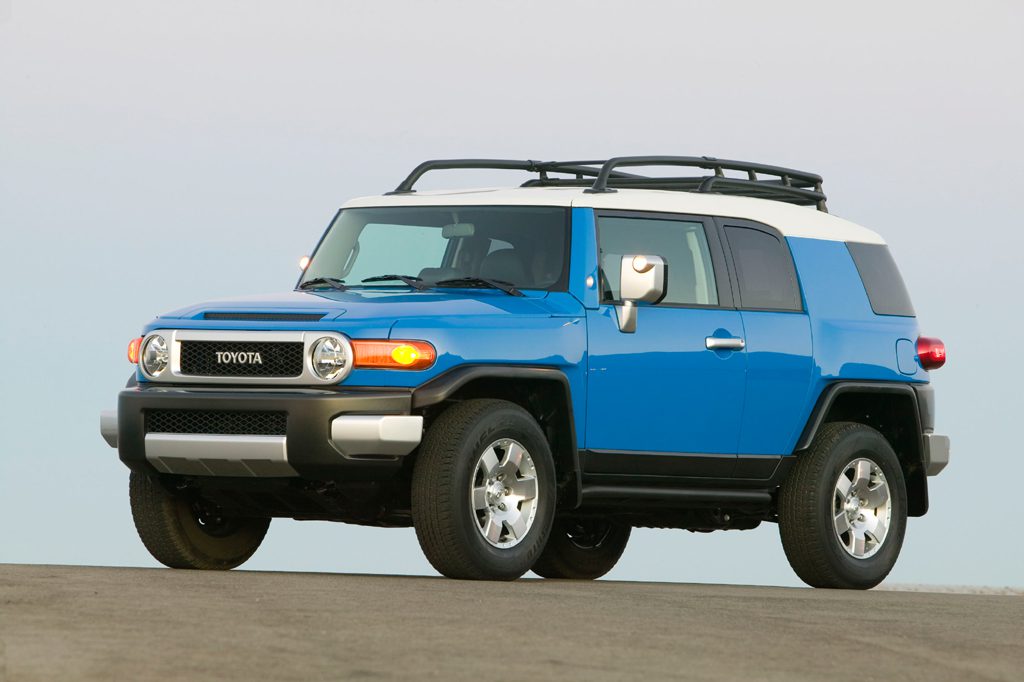| Midsize SUV; Built in Japan |
|
|
| Good condition price range: $12,800 – $36,400* |

2008 Toyota FJ Cruiser

2008 Toyota FJ Cruiser

2008 Toyota FJ Cruiser

2008 Toyota FJ Cruiser
| Pros: |
|
| Cons: |
|
Solidly built, Toyota’s FJ Cruiser looks like no other SUV on the market. Unfortunately, the FJ pays a price for its exaggerated styling and off-road-biased engineering. Specifically, on-road performance and daily practicality don’t match those of less-radical rivals. Somewhat strong resale value keeps used FJ prices a bit high.
Overview
Toyota wanted something different with the FJ Cruiser, and got it. Based on the 4Runner but far different in appearance, this new midsize sport-utility vehicle featured styling inspired by Toyota’s 1960s-era Land Cruisers. Each FJ Cruiser seated five and had two main doors, two rear-hinged rear access doors, with no pillar between. A swing-out cargo door had opening glass and mounting for the spare tire. FJs came with rear-wheel drive or four-wheel drive. Sole engine was a 239-horsepower V6. A five-speed automatic transmission was standard. The 4WD version also was available with a manual transmission. Two 4WD systems were used. Both had low-range gearing, but only the 4WD system used with manual transmissions could be left engaged on dry pavement.
Rear-drive FJs included a limited-slip rear differential. A locking rear differential was standard with the manual transmission and 4WD, optional otherwise. All FJs had antilock braking, traction/antiskid control, and mud/snow tires. Available with 4WD was Toyota’s A-TRAC off-road traction control system. Front side airbags and curtain side airbags were optional. So were a rear-obstacle detection system and an inclinometer showing vehicle tilt. Though the FJ was in something of a class by itself, rivals included the Hummer H3, Jeep Wrangler, and Nissan Xterra.
Yearly Updates
| 2008 FJ Cruiser Curtain airbags and front side airbags joined the standard-equipment list for 2008. A new Off-Road Package became optional. Toyota announced that 3,200 Trail Team Editions would be built in mid-season. Dealers could now install a TRD supercharger, boosting engine output to 304 horsepower. |
| 2009 FJ Cruiser A rearview camera was newly available on the 2009 FJ Cruiser. |
| 2010 FJ Cruiser The Toyota FJ Cruiser’s sole engine received more power in 2010, with an upgrade of horsepower from 239 to 258. |
| 2011 FJ Cruiser The 2011 Toyota FJ Cruiser saw only minor trim changes. |
| 2012 FJ Cruiser There were no changes of note to the 2012 Toyota FJ Cruiser. |
| 2013 FJ Cruiser There were fairly minor tweaks for the 2013 model year. The Trail Teams Special Edition package switched from Radiant Red exterior paint to Cement Gray. Other models were offered in a new shade of orange called Magma. The only other change of note was the addition of standard power outside mirrors with marker lights. |
| 2014 FJ Cruiser FJ Cruiser’s final model year was 2014. Toyota announced production of 2500 Trail Teams Ultimate Edition models as a send off. All were finished in Heritage Blue paint with a white grille surround. |
